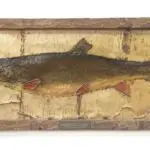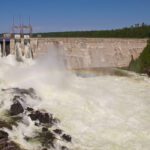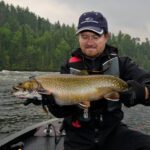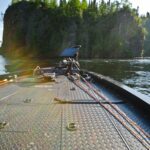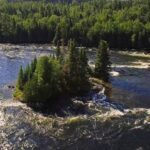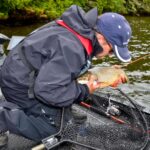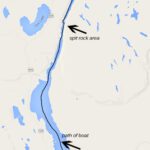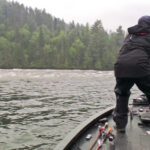NIPIGON HISTORY
Can you imagine catching a 14 pound 8 ounce Brook Trout? Or even crazier, the double hook-up of a 5 and a 6.8 pounder on a single line with two baits the very next day?
That’s what the Nipigon River in Northern Ontario was like 100 years ago. Imagine an afternoon catch of literally a barrel of five-pounders. Brook Trout heaven—beyond anything we can imagine today.
This 48 kilometre stretch of water running from Lake Nipigon to Lake Superior, over a descent of 95 metres, was too powerful a torrent for the government to ignore. Power development began in the Nipigon Signature Site in 1918, and five dams and thirty years later (with the completion of the Pine Portage Dam in 1950), the shape of this magnificent waterway had completely changed.
The end result: the damming has increased water levels over a hundred feet, and flooded out almost 16 kilometres of whitewater, rapids, waterfalls, and pools. The government got its power all right, but it destroyed the Brook Trout ecosystem and rapidly depleted its population.
Ontario Power Generation and the Ministry of Natural Resources and Forestry, along with many other regional Remedial Action Teams, have been working since the 1970s to restore the Brook Trout population back to what it was in the 1930s. That, along with the spectacular Brook Trout fishing, is why we decided to shoot the mighty Nipigon. We’re celebrating the success of this disciplined management, as indicated by the resurgence of these amazing fish.
And what better way to celebrate this success than with a festival? The Nipigon River Brook Trout Festival, held in July on the anniversary of Dr. Cook’s boating of the largest Brook Trout ever caught, way back in 1915.
SALVELINUS FONTINALIS
The Latin name for Brook Trout is Salvelinus Fontinalis, which means spring-dwelling char. Fitting, as the Brook Trout is more closely related to Grayling and Arctic Char than to the more commonly found Rainbow and Brown Trout. The god Manitou, according to Iroquois legend, was so taken with the Brook Trout’s sleek beauty that he refused to eat it. Instead, he threw it back into the stream he’d plucked it from, leaving his fingerprints as jewel-like speckles on the fish’s back and sides.
Brook Trout numbers and size are the draws here. Especially size. The brookies grow really big here because, aside from their need for fresh, clean, cold, fast-moving and well-aerated water, they must also have—as their Latin name suggests—spring water.
NIPIGON RIVER ACCESS
The most astonishing part of a trip to the Nipigon River is access. With raging rapids from top to bottom, the unknowing angler might think the Nipigon is only accessible by freighter canoe, portage points, and a seasoned local guide. This could not be further from the truth.
“I drove up from southern Ontario with our big Princecraft, dropped it in the water, drove through one of the most scenic boat rides ever, and was fishing in no time,” recalls Pete Bowman. “I do recommend a guide for your first day on the water, however, to familiarize yourself not only with the fishing, but navigation as well.”
THE FEMALE BROOKIES
The successful development of fertilized Brook Trout eggs requires extensive groundwater discharge areas for spawning.
In the fall, at specific areas of the river, female Trout dig nests and bury their eggs in gravel substrates. During the four-month incubation period, the embryos are bathed in groundwater that flows through the gravel because of special geologic characteristics of the bank and adjacent lands.
Who’d have thought that the shoreline was as important to the spawn as the quality of the water?
A PERFECT SPOT
Lake Nipigon, the source of the Nipigon River, is the largest lake entirely in Ontario and, in fact, it’s the 38th largest lake in the world.
It has a perimeter of 1,050 km, and a north-south length of about a 110 km. It’s about 80 km wide, with a maximum depth of 165 meters—or 540 feet for us old-schoolers.
All of this water keeps the river ripping, year after year.
“For a fishing trip like this,” says Pete, “I try to prepare as best I can. I know my dad and his friends had amazingly successful days with big spoons. I’ve done well here in the past with bright coloured jigs, as well as spinners and small shiny spoons, so I’m good there. However, I had a hunch that a drop shot rig would work here as well. With soft plastics resembling minnows, insect larvae, and sculpins, as well as keeping a safety backup of live crawlers, I figured this rig could be a killer. And I was right.”
This river is known for its big Brook Trout, but it’s also known for its rapids. So Pete tucked the boat in a protected area just outside some of the craziest water he’s ever fished. It was, in his opinion, a perfect spot.
He caught fish after fish, drifting his drop shot rig down current for hungry specks.
“I’ve never had this before on a trophy brookie area,” says Pete. “But I had this little area dialled in so well that I was literally expecting a fish on every cast.”
Well, maybe not every cast—but it was pretty darned close!
TAGGED BROOKIE
Pete had a rather rare experience on this trip: He caught a tagged Brook Trout. Since he was on a strict catch and release trip, he temporarily put the fish in the livewell where he could take a picture of the tag for future reference.
“As soon as I returned to the office after this trip,” says Pete, “I contacted the Nipigon MNR with the tag information of this fish. It was a three-year-old fish that was originally tagged on September 23rd, 2014 above the Pine Portage Dam in West Bay of Lake Nipigon. Somehow, this resilient little Terminator traveled to the dam, came crashing down water that no human could ever survive, came out pretty much unscathed, and is still voraciously feeding to this day.”
To say the Brook Trout is a tough beast is definitely an understatement!
In Pete’s opinion, it’s a bucket-lister that every angler should try.
“You know something?” Pete takes a moment to consider his recent experience before summarizing his thoughts: “The Nipigon River still continues to impress even a hundred years after its then justly celebrated fame. And in my opinion, with proper fish and water management, world-class Brook Trout fishing will be available for generations to come.”
SPECIAL THANKS
- Ontario’s North of Superior
- Nipigon River Adventures
- Daniela Carlino – Videographer at Parks Canada
- Go Fish Ontario




